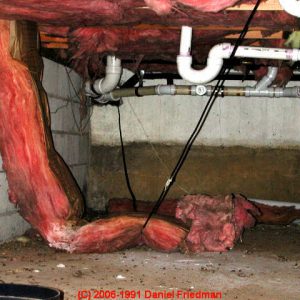In laymen’s terms, R-value is the measurement of how well a product insulates. To explain why traditional fiberglass insulation doesn’t perform well in basement wall assemblies we need to understand the difference between “Nominal” R-values and “Effective” R-values.
To help explain the difference between Nominal and Effective R-values we will look at a sandwich as an analogy. In this analogy lets imagine we are judging something on how well it tastes. There are many types and qualities of bread, and some may taste better than others. However, if you were to make a sandwich with very tasty bread, and nothing else, would that really be a tasty sandwich? No, it would be bland and terrible. However, when you add other products into the sandwich (meat, mayo, lettuce, cheese) well, then that sandwich is going to be delicious. Therefore, we must measure how delicious a sandwich is based on the entire sandwich, not just on the bread alone. That is the difference between Nominal R-value, and Effective R-value. Nominal R-value (the bread in our analogy) is based on how well a specific material insulates with no other products taken into consideration. Effective R-value (the sandwich in our analogy) is based on how well a building assembly performs in its entirety. Effective R-value is a true R-value. The R-value for fiberglass is based on its Labelled or Nominal R-value.
 Now lets take a look at what happens to Nominal R-20 fiberglass installed in a wood frame assembly. Remember, R-20 fiberglass is its rated R-value by itself, it does not consider wood framing, or concrete, or real world applications. Once R-20 fiberglass is installed in a 16 O.C. wood stud wall the R-value drops to somewhere between R-15.8 and R-13.4. This R-value is considered Effective R-value because it takes into account the wood studs. The reason why the R-value drops when the insulation is added into a wood frame assembly is due to thermal bridging. A study done on the effects of thermal bridging states that “[t]hermal bridges provide a path of lesser resistance through the insulation, allowing more heat to bypass the thermal barrier and raise or lower interior temperatures”. Basically, energy travels through the wood studs easier than the insulation. That wasted energy could have been used to heat your basement.
Now lets take a look at what happens to Nominal R-20 fiberglass installed in a wood frame assembly. Remember, R-20 fiberglass is its rated R-value by itself, it does not consider wood framing, or concrete, or real world applications. Once R-20 fiberglass is installed in a 16 O.C. wood stud wall the R-value drops to somewhere between R-15.8 and R-13.4. This R-value is considered Effective R-value because it takes into account the wood studs. The reason why the R-value drops when the insulation is added into a wood frame assembly is due to thermal bridging. A study done on the effects of thermal bridging states that “[t]hermal bridges provide a path of lesser resistance through the insulation, allowing more heat to bypass the thermal barrier and raise or lower interior temperatures”. Basically, energy travels through the wood studs easier than the insulation. That wasted energy could have been used to heat your basement.
Metal studs are even more conductive than wood. R-20 fiberglass falls dramatically down to an Effective R-value between 5.2 and 7.1 when we insert a more conductive product like steel studs. That is almost a 75% loss in R-value. The more conductive a material is the more potential for energy loss, which is why we don’t insulate our homes with pots and pans, or cook our eggs on insulation. Thermal bridging also causes problems with condensation on interior side of concrete walls. This is due to heat travelling through the framing member and meeting the cold concrete wall. Now we have condensation, and potential for moisture. How do we solve this thermal bridging problem? To avoid thermal bridging it is necessary to have a continuous thermal barrier. Basically, you need something that insulates between the framing members and the concrete wall. By installing foam insulations like EPS between the framing members and the concrete wall we can nullify the problem of thermal bridging. Yet, thermal bridging is not the only thing that can drastically reduce the Effective R-value.
 We discussed earlier the high potential for moisture in basements, and the health hazards that coincide with moisture problems. Well, moisture doesn’t just help mould grow, moisture also destroys Effective R-values. The IRC have conducted studies showing that when moisture is found in insulation there is “a reduction [in R-value] of 60 to 70%” and that “reduction is so drastic that it is debatable whether the material can be considered thermal insulation”. Therefore, moisture is detrimental to the effectiveness of insulation. Oh, air infiltration reduces the Effective R-value more than the majority of the problems we just discussed. That poly vapour barrier better be sealed perfectly. Learn more about R-value at quiktherm.com.
We discussed earlier the high potential for moisture in basements, and the health hazards that coincide with moisture problems. Well, moisture doesn’t just help mould grow, moisture also destroys Effective R-values. The IRC have conducted studies showing that when moisture is found in insulation there is “a reduction [in R-value] of 60 to 70%” and that “reduction is so drastic that it is debatable whether the material can be considered thermal insulation”. Therefore, moisture is detrimental to the effectiveness of insulation. Oh, air infiltration reduces the Effective R-value more than the majority of the problems we just discussed. That poly vapour barrier better be sealed perfectly. Learn more about R-value at quiktherm.com.
